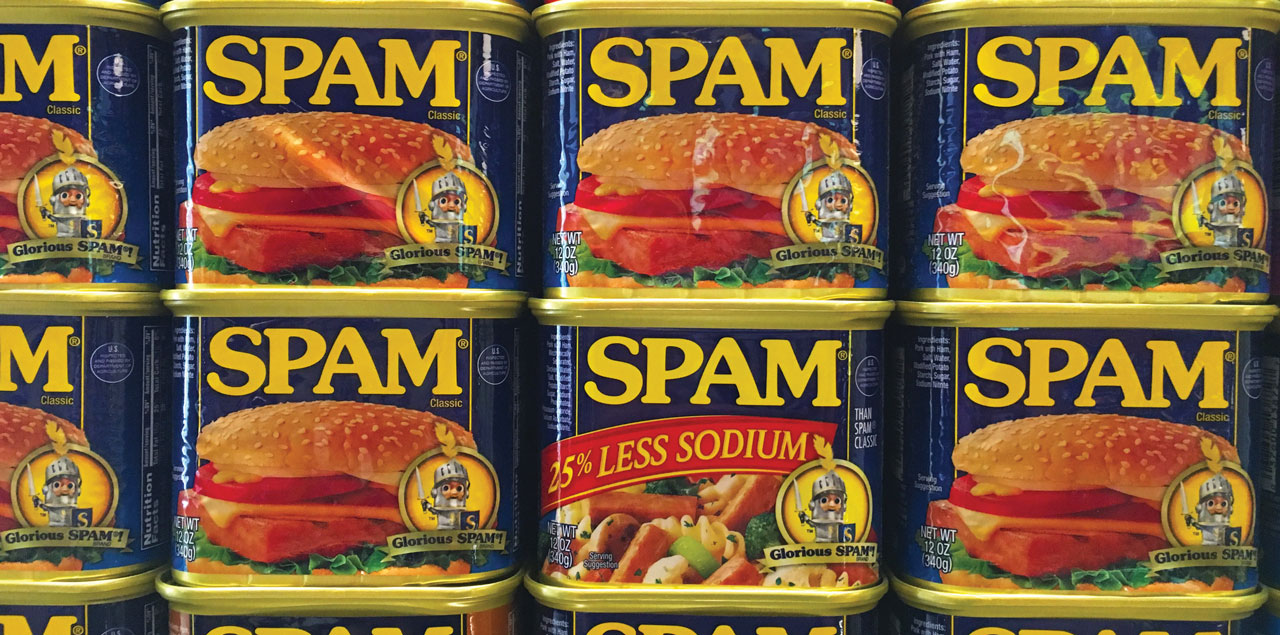When I hear the word “spam,” my first thought is of the meat. I grew up eating Spam. For a long time, I thought everyone ate it, and now I realize that, back then, it was for poor folks.
I still eat Spam, but these days, I tend to think of it as a health food (at least that’s what I tell myself when I’m eating it). I know it contains the vitamins E-I-E-I-O. The rest of its ingredient list should probably read, “Contains an oink, oink here and a moo, moo there with a dash of a quack, quack.”
Still, Spam is one of the foods that take me back to my childhood. You can serve it at every meal. For breakfast, you can have Spam and scrambled eggs or fried eggs and Spam. For lunch, get yourself a couple of pieces of bread and make yourself a Spamburger. For dinner, you can choose from Spam and macaroni or Spam kabobs, BBQ Spam, chicken-fried Spam and Spam casserole, just to name a few.
You don’t even have to cook it; you can eat it right out of the can. Only your imagination limits you on the way you can prepare and consume Spam.
And now, it not only comes with vitamins E-I-E-I-O but with 25 percent less sodium, which has me scratching my head. How much salt was in there in the first place? Maybe that’s how God turned Lot’s wife into a pillar of salt: She ate too much Spam.
For a missionary like me who lives off the grid where there is no running water or any type of refrigeration, Spam is one of the staples of life. And it’s a fun food to eat when you are living in a hut with no electricity.
When you pull it out of the can, it makes the same sound as when you are trying to pull a stuck foot out of the mud. You’re right; it doesn’t take much to entertain me.
This week, I have been in Mexico, taking a team of students on a rite of passage trip. This was the first trip where were our younger staff used social media to broadcast our activities to the world.
I am not sure what all they did, but it had to do something with “live feed,” “Twitter,” “Snapchat,” “Instagram” and a bunch of other Greek words. Thousands of people joined us through the internet as our students presented the Gospel, and more than 200 were led to Christ.
Toward the end of the week, I pulled out my phone to check my email. I couldn’t believe it. I had hundreds of emails offering me products I didn’t need.
Many of the emails were in a foreign language, and a number of those said I needed to call the sender. Several were asking me to come to Africa to preach to tens of thousands; all I had to do was pay my way.
As I scrolled down, I became frightened at how many crazy emails I saw. I had always known that one day, with these young people using social media, my email would be hacked.
I took my phone over to one of the younger leaders to show her. “Look at all these emails,” I told her. “I must have hundreds of hacks!” She looked at my phone and said, “That is not your inbox; it’s your ‘junk folder.’” She hit the inbox icon on my phone, and there was my normal list of emails.
I felt embarrassed. Somehow, I had forgotten that my email account has a filter to separate the good emails from the bad. I had accidentally opened—you guessed it—the “spam” folder.
I am glad I have that filter on my phone. I can’t imagine what life would be like if all that junk came in every day and I had to deal with it.
Did you know the Bible says we should do the same when wrong thoughts come to our mind? We need to take every thought captive and evaluate it. Does it go to our inbox or does it go to the spam folder to delete?
It’s not too difficult to determine which thoughts go into which folder. If it goes against the Word and the will of God, it is junk and doesn’t need to be in our lives.
“We demolish arguments and every pretension that sets itself up against the knowledge of God, and we take captive every thought to make it obedient to Christ” (2 Cor. 10:5).
There is Spam, and then there is spam. One is good, and one is bad. Make sure you know the difference.



